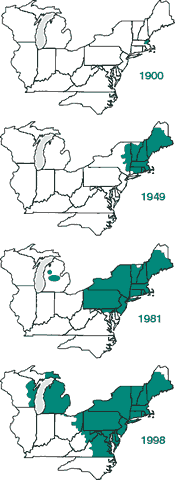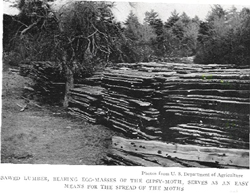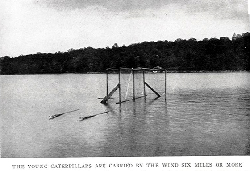
How Gypsy Moths Spread
This section provides information on the ways that gypsy moths spread around the country.
Gypsy Moths spread in the following ways:
1. Early on, when still small
and lightweight, the caterpillars drop down from tree branches on silk-like threads and are blown by the wind to
other trees.
2. As caterpillars, they will crawl on things like car tires and thus get spread around.
3. The females lay their eggs on tree trunks, branches, and leaves. They also lay them on all sorts of things such as bags of mulch, stacked firewood, etc.
When these items are transported elsewhere, the eggs go with them where ever they go.
4. The females lay their eggs on car and truck tires and wheels. The eggs may stay on the wheels until the
following spring or they might drop off wherever. Then they will hatch next spring wherever they are at that time.
The egg masses are tough and stick to what ever they are laid on.
Link to examples of where eggs are laid - Where gypsy moth eggs are laid
Link to example of eggs sticking to the wheels of an SUV:
Gypsy Moth eggs on SUV wheels
What they knew about the spread of gypsy moths in 1914
The information below is from the July, 1914 issue of National Geographic Magazine.
From 1892 to 1900 gypsy moths were confined to the eastern portion of the State of Massachusetts. However, by 1905 they had spread to New Hampshire, Maine, Rhode Island and Connecticut.
By then in Massachusetts, orchard and shade trees were dying, the parks and dooryards were stripped of all kinds of foliage. In June, the wooded hill sides were brown when they should have been green. And in the villages and towns during the latter part of May and through June, caterpillars were crawling everywhere - on the sidewalks, on the sides of houses, and even in houses.
The United States Congress got involved as the gypsy moths became a national problem in the year 1905. They appropriated funds to eradicate and stop the spread of gypsy moths.
It was first believed that gypsy moths spread while in the caterpillar stage by crawling on trolley cars, automobiles and other vehicles and also upon the clothing of pedestrians. They believed that gypsy moths were carried, for the most part, along the traveled highways and thus gained a large territorial spread.
Sawed lumber bearing
gypsy moth egg masses
Gypsy Moth
wire collection screens
Products shipped from infested regions were soon identified as a major source of spread. The photo on the right shows sawed lumber bearing egg-masses of the gypsy-moth as an easy means for the spread of the moths when it is shipped out of the district. Inspection systems were set up and the Federal Horticulture Board was established to manage quarantine of the rest of the country against the region inhabited by gypsy-moths.
Also it was discovered that, as the young caterpillar of the gypsy moth hatches from the egg it spins down on warm days suspended by a silken thread, is caught by the wind and carried sometimes for miles before it succeeds in attaching itself to a tree or shrub. Large scale experiments were conducted by erecting enormous wire screens, as shown by the photo on the right, at various distances windward from infested woods. Collections by the screens, being coated with a sticky substance, have shown that many young caterpillars are carried in this way to distances of 6 miles or more.

Gypsy moth spread map
University of Wisconsin
Where Gypsy Moths Are Now
From their unfortunate start in Medford Massachussets, gypsy moths have now spread to many other portions of the United States
From 1892 to 1900 gypsy moths were confined to the extreme eastern portion of the State of Massachusetts.
By 1914 they had spread to New Hampshire, Maine, Rhode Island, and Connecticut.
By 1941 they were in Northeastern Pennsylvania and in extreme eastern New York State.
By 1981 they were all over Pennsylvania and New Jersey.
They have now spread to many other states, including Michigan and Wisconsin, as shown on the map on the right.
Gypsy Moths are now also in Virginia, West Virginia and Oregon. How did they get to Oregon? It is believed that they hitchhiked on a car or truck.
They continue to spread.

